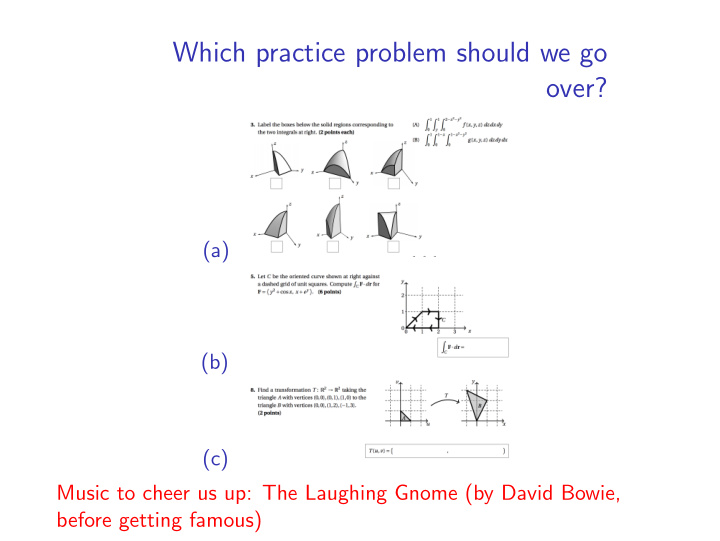



Which practice problem should we go over? (a) (b) (c) Music to cheer us up: The Laughing Gnome (by David Bowie, before getting famous)
About the exam ∙ Consider the following integral: ∫︂ b ∫︂ d g ( x , y ) dy dx . a c • The function g ( x , y ) is called the integrand . • Some questions will specifically ask you to set up the integral or find the integrand. Don’t waste your time evaluating the integral if you’re not required to. • Read carefully! ∙ Extra office hours today 2–3:20pm. ∙ More office hours tomorrow 11–12:20pm. ∙ No lecture on Wednesday.
Remarks on integrals over curves and surfaces ∙ For integrating over curves, we use the unit tangent vector. • At a given point, there are only two choices of unit tangent vector. • A choice of orientation on the curve tells us which one to pick. ∙ But over a surface, there are infinitely many unit tangent vectors attached to any point (all in the tangent plane of that point). • But there aren’t infinitely many choices of normal vectors to the tangent plane: there are only two— r u × r v and r v × r u = − r u × r v . • A choice of orientation on the surface tells us which one to pick at each point. • For surfaces, there isn’t always a good choice! We’ll see examples. We will only be able to integrate vector fields over surfaces with orientation.
Practice with surface orientation Take a strip of paper, and tape the ends together (without twisting) to form a cylinder. Is it orientable? (a) Yes. (b) No. (c) I don’t know. (d) I’m so excited to find out what happens when we twist the paper that I can’t focus on this question. (e) I can’t answer this question, because I don’t have any tape or imagination.
Practice with surface orientation Now tape the ends of the paper together with a half-twist. This is a M¨ obius strip. Is it orientable? (a) Yes. (b) No. (c) I don’t know.
Practice with integrating over a surface Let S be the graph of a function f : D → R , oriented upward, and let F be a continous vector field on S . Find a formula for ∫︁∫︁ S F · d S as a double integral over D . Step 1: Parametrize S We know what to do for graphs of functions: r ( u , v ) = ⟨ u , v , f ( u , v ) ⟩ , ( u , v ) ∈ D . Step 2: Find r u × r v and compare it to n The first part is also probably review: r u = ⟨ 1 , 0 , f x ⟩ ; r v = ⟨ 0 , 1 , f y ⟩ .
So ⃒ ⃒ i j k ⃒ ⃒ ⃒ ⃒ r u × r v = 1 0 f x ⃒ ⃒ ⃒ ⃒ 0 1 f y ⃒ ⃒ = i ( − f x ) − j ( f y ) + k (1) = ⟨− f x , − f y , 1 ⟩ . Compare r u × r v to n , recalling that S is oriented upward. (a) r u × r v is positively oriented. (b) r u × r v is negatively oriented. (c) I don’t know.
Step 3: calculate the integral Working with your neighbour, find a formula for the integrand g ( u , v ) to write ∫︂∫︂ ∫︂∫︂ F ( x , y , z ) · d S = g ( u , v ) dA . S D (a) We’re working on it. (b) We’re stuck. (c) We have two answers and we don’t know which is right. (d) We’re done!
Recommend
More recommend